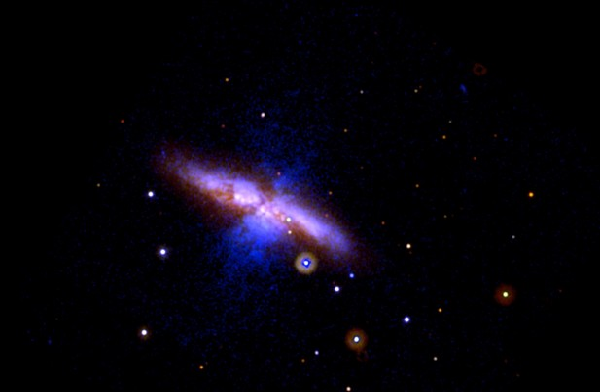Astronomers Learn about Supernova by Discovering Nothing
| Paula Marie Navarra | | Aug 17, 2014 10:21 AM EDT |
Astronomers that witnessed a Type Ia supernova said they caught a glimpse of the powerful supernova by detecting nothing.
The Type Ia supernova occurred in a galaxy called Messier 82 and was detected by astronomers using the Chandra X-ray Observatory .
Messier 82, otherwise called the Cigar Galaxy, is a starburst galaxy about 12 million light years away in the Ursa Major constellation.
Like Us on Facebook
It's five time more luminous than our Milky Way galaxy and a hundred times more luminous than other galaxies.
The Type Ia supernova in Messier 82 was possibly triggered by a white dwarf that absorbed too much mass from its companion star.
Astronomers searching for the exact location of the supernova were unable to detect the source since the region around the site of the supernova was devoid of material.
Rafaella Margutti of the Harvard-Smithsonian Center for Astrophysics said even though it might sound odd, astronomers learned a great deal about the supernova by detecting nothing.
She said they can now rule out the explosion was caused by a white dwarf that continuously pulled material from a companion star.
Margutti said the supernova called SN 2014J might have been formed by the merger of two white dwarfs, a phenomena that results in little or no X-rays after an explosion.
Atish Kamble, one of the astronomers involved in the study, said eliminating the possible explanation for the cause of the SN 2014J explosion is a big step. The next step is to narrow further reasons for the explosion.
Astronomers said Type Ia supernovae are used as cosmic-distance markers. Supernovae are considered a key in discovering the universe's accelerated expansion.
The supernova that occurred at Messier 82 gives scientists the chance to observe details that would be hard to detect in more distant supernova.
Jerod Parrent, another astronomer involved in the study, said the SN 2014J explosion could be a chance of lifetime to study a supernova up close and personal.
©2015 Chinatopix All rights reserved. Do not reproduce without permission
EDITOR'S PICKS
-

Did the Trump administration just announce plans for a trade war with ‘hostile’ China and Russia?
-

US Senate passes Taiwan travel bill slammed by China
-

As Yan Sihong’s family grieves, here are other Chinese students who went missing abroad. Some have never been found
-

Beijing blasts Western critics who ‘smear China’ with the term sharp power
-

China Envoy Seeks to Defuse Tensions With U.S. as a Trade War Brews
-

Singapore's Deputy PM Provides Bitcoin Vote of Confidence Amid China's Blanket Bans
-

China warns investors over risks in overseas virtual currency trading
-

Chinese government most trustworthy: survey
-

Kashima Antlers On Course For Back-To-Back Titles
MOST POPULAR
LATEST NEWS
Zhou Yongkang: China's Former Security Chief Sentenced to Life in Prison

China's former Chief of the Ministry of Public Security, Zhou Yongkang, has been given a life sentence after he was found guilty of abusing his office, bribery and deliberately ... Full Article
TRENDING STORY

China Pork Prices Expected to Stabilize As The Supplies Recover

Elephone P9000 Smartphone is now on Sale on Amazon India

There's a Big Chance Cliffhangers Won't Still Be Resolved When Grey's Anatomy Season 13 Returns

Supreme Court Ruled on Samsung vs Apple Dispute for Patent Infringement

Microsoft Surface Pro 5 Rumors and Release Date: What is the Latest?










